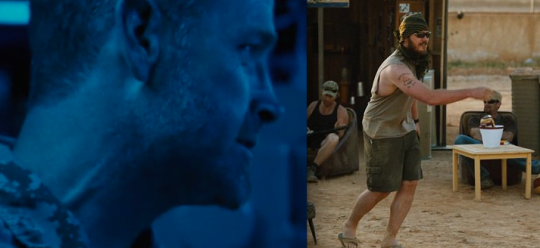Can you spoil real life events that take place in movies? If so, some spoilers for the ends of Captain Phillips and Zero Dark Thirty below.
In my review of Captain Phillips, opening today, I write that "the calm, cold, calculating competence of the Navy SEALs and their commander, who are eventually called in to rescue Phillips, keeps the film from devolving into spectacle." I'd like to expand on this a bit and compare and contrast the treatment of SEAL Team Six in Captain Phillips and Zero Dark Thirty.
In Zero Dark Thirty, Kathryn Bigelow's film chronicling the pursuit, and killing, of Osama bin Laden, we are treated to a few scenes of the SEALs before the climactic raid. Joking with each other, playing horseshoes in the desert sand, and sporting wild beards, they are less elite killing machines than frat-bros waiting for the Alabama-Auburn game to kick off. As they copter into bin Laden's compound they joke around with each other and discuss motivational speakers—the scene is reminiscent of the opening of Predator, in a way.
Then, when the actual assault begins, a switch flips and they go pro. Their eyes deaden and narrow: target acquisition is all that matters. The audience—which would likely be cheering for them anyway, given the target—isn't disturbed by this shift into machine mode because we've seen them as people. The raid is clean (more or less), quick, and efficient: one dead terror mastermind, a couple of flunkies left cold, and a treasure trove of data for the CIA to pore through. The excellence of the SEALs is given a human face, one that allows us to join in their joy and share their triumph.*
Contrast that to the treatment of SEAL Team Six in Captain Phillips. With the exception of the team commander, played by Max Martini (who you may remember from The Unit, one of the more underrated cultural artifacts of the post-9/11 landscape), we see little more than shadowy glimpses of the team: a splashdown at sea when they parachute in; a shot of a series of bald, clean-shaven men stalking toward their sniper's nest at the front of the ship; and eyes peering through scopes toward the lifeboat on which Richard Phillips is being held hostage by four Somalian pirates.
Martini plays his part with his usual weary-but-commanding presence. He exudes calm excellence, barking out orders to both his team and the ship's crew. He does not smile—he may not even know how. As the tension mounts and his men try to get a simultaneous bead on the pirates through minuscule windows on a tiny ship being rocked by the wake of a massive Navy destroyer, the audience is gripped by the inevitability of what is about to transpire.
The chilly calm of SEAL Team Six dampens whatever triumph one might have felt by the successful conclusion of their mission. (Spoiler alert: They kill a bunch of pirates and rescue Captain Phillips.) Indeed, audiences may even be a bit perturbed by their stark professionalism. I remember when this whole thing went down how pumped everyone was—"America, f—k yeah! Take that pirate scum!" and all that. The way director Paul Greengrass shoots the scenes with the SEALs is a rather explicit rejection of that reaction. These are ruthlessly efficient men doing a dirty but necessary job. There is no triumph here. Just work well done.
*That being said, the final shot of the film—which shows Maya (Jessica Chastain) crying, exhausted, and lost—keeps the film from feeling triumphalist. There's a difference!
